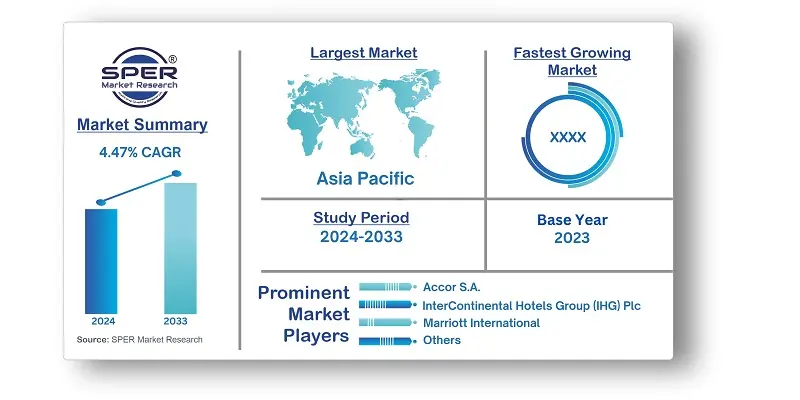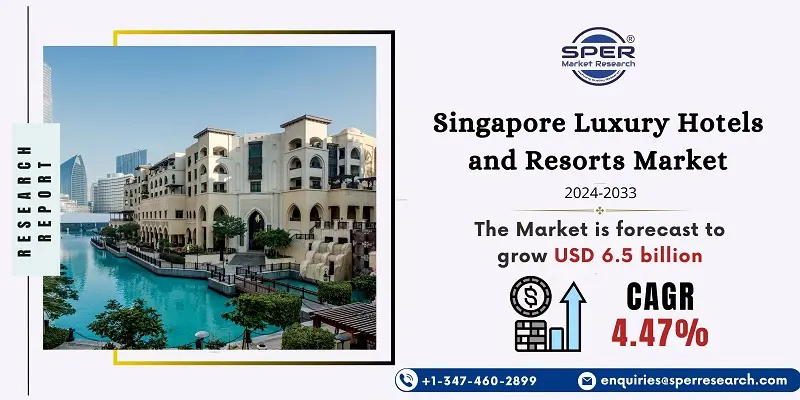
Singapore Luxury Hotels and Resorts Market Trends, Share, Demand, Revenue and Future Outlook
Singapore Luxury Hotels and Resorts Market Growth, Size, Trends Analysis- By Type, By Segment- Regional Outlook, Competitive Strategies and Segment Forecast to 2033
| Published: Oct-2024 | Report ID: FMCG24165 | Pages: 1 - 107 | Formats*: |
| Category : Consumer & Retail | |||
- December 2023: With a historic agreement with Worldwide Hotels Group—the nation's largest hotel operator by room count and Accor's longtime partner—the largest international hospitality group in the Middle East, Africa, and Asia Pacific is bringing the largest Mercure hotel in the world—with 989 keys—to Singapore.
- The Singapore Airlines Group and Sarovar Hotels & Resorts global rewards program KrisFlyer announced in May 2023 that they would be collaborating to offer flyers and travelers exclusive benefits.


| Report Metric | Details |
| Market size available for years | 2020-2033 |
| Base year considered | 2023 |
| Forecast period | 2024-2033 |
| Segments covered | By Type, By Segment. |
| Regions covered | Eastern Region, Western Region, Northern Region, Southern Region. |
| Companies Covered | Accor S A, Far East Hospitality, Forward Land, Hotel 81, InterContinental Hotels Group Plc, Marina Bay Sands, Marriott International, Millennium & Copthorne International Limited, and Pan Pacific Hotels Group. |
- Affluent Travelers
- Business Executives
- Couples and Honeymooners
- Families
- International Tourists
- Special Event Guests
- Wellness Seekers
- Eco-conscious Travelers
| By Type: | |
| By Segment: |
- Singapore Luxury Hotels and Resorts Market Size (FY’2024-FY’2033)
- Overview of Singapore Luxury Hotels and Resorts Market
- Segmentation of Singapore Luxury Hotels and Resorts Market By Type (Chain Hotels, Independent Hotels)
- Segmentation of Singapore Luxury Hotels and Resorts Market By Segment (Therapeutic, Diagnostic, Biotechnology and Pharmaceutical Industry, Others)
- Expansion Analysis of Singapore Luxury Hotels and Resorts Market
- Problems and Obstacles in Singapore Luxury Hotels and Resorts Market
- Competitive Landscape in the Singapore Luxury Hotels and Resorts Market
- Impact of COVID-19 and Demonetization on Singapore Luxury Hotels and Resorts Market
- Details on Current Investment in Singapore Luxury Hotels and Resorts Market
- Competitive Analysis of Singapore Luxury Hotels and Resorts Market
- Prominent Players in the Singapore Luxury Hotels and Resorts Market
- SWOT Analysis of Singapore Luxury Hotels and Resorts Market
- Singapore Luxury Hotels and Resorts Market Future Outlook and Projections (FY’2024-FY’2033)
- Recommendations from Analyst
1.1. Scope of the report1.2. Market segment analysis
2.1. Research data source
2.1.1. Secondary Data2.1.2. Primary Data2.1.3. SPER’s internal database2.1.4. Premium insight from KOL’s
2.2. Market size estimation
2.2.1. Top-down and Bottom-up approach
2.3. Data triangulation
4.1. Driver, Restraint, Opportunity and Challenges analysis
4.1.1. Drivers4.1.2. Restraints4.1.3. Opportunities4.1.4. Challenges
4.2. COVID-19 Impacts of the Singapore Luxury Hotels and Resorts Market
5.1. SWOT Analysis
5.1.1. Strengths5.1.2. Weaknesses5.1.3. Opportunities5.1.4. Threats
5.2. PESTEL Analysis
5.2.1. Political Landscape5.2.2. Economic Landscape5.2.3. Social Landscape5.2.4. Technological Landscape5.2.5. Environmental Landscape5.2.6. Legal Landscape
5.3. PORTER’s Five Forces
5.3.1. Bargaining power of suppliers5.3.2. Bargaining power of buyers5.3.3. Threat of Substitute5.3.4. Threat of new entrant5.3.5. Competitive rivalry
5.4. Heat Map Analysis
6.1. Singapore Luxury Hotels and Resorts Market Manufacturing Base Distribution, Sales Area, Product Type6.2. Mergers & Acquisitions, Partnerships, Product Launch, and Collaboration in Singapore Luxury Hotels and Resorts Market
7.1. Singapore Luxury Hotels and Resorts Market Size, Share and Forecast, By Type, 2020-20267.2. Singapore Luxury Hotels and Resorts Market Size, Share and Forecast, By Type, 2027-20337.3. Chain Hotels7.4. Independent Hotels
8.1. Singapore Luxury Hotels and Resorts Market Size, Share and Forecast, By Segment, 2020-20268.2. Singapore Luxury Hotels and Resorts Market Size, Share and Forecast, By Segment, 2027-20338.3. Therapeutic8.4. Diagnostic8.5. Biotechnology and Pharmaceutical Industry8.6. Others
9.1. Singapore Luxury Hotels and Resorts Market Size and Market Share
10.1. Singapore Luxury Hotels and Resorts Market Size and Market Share By Region (2020-2026)10.2. Singapore Luxury Hotels and Resorts Market Size and Market Share By Region (2027-2033)10.3. Eastern Region10.4. Western Region10.5. Northern Region10.6. Southern Region
11.1. Accor S A
11.1.1. Company details11.1.2. Financial outlook11.1.3. Product summary11.1.4. Recent developments
11.2. Far East Hospitality
11.2.1. Company details11.2.2. Financial outlook11.2.3. Product summary11.2.4. Recent developments
11.3. Forward Land
11.3.1. Company details11.3.2. Financial outlook11.3.3. Product summary11.3.4. Recent developments
11.4. Hotel 81
11.4.1. Company details11.4.2. Financial outlook11.4.3. Product summary11.4.4. Recent developments
11.5. InterContinental Hotels Group Plc
11.5.1. Company details11.5.2. Financial outlook11.5.3. Product summary11.5.4. Recent developments
11.6. Marina Bay Sands
11.6.1. Company details11.6.2. Financial outlook11.6.3. Product summary11.6.4. Recent developments
11.7. Marriott international
11.7.1. Company details11.7.2. Financial outlook11.7.3. Product summary11.7.4. Recent developments
11.8. Millennium & Copthorne International Limited
11.8.1. Company details11.8.2. Financial outlook11.8.3. Product summary11.8.4. Recent developments
11.9. Pan Pacific Hotels Group
11.9.1. Company details11.9.2. Financial outlook11.9.3. Product summary11.9.4. Recent developments
11.10. Others
SPER Market Research’s methodology uses great emphasis on primary research to ensure that the market intelligence insights are up to date, reliable and accurate. Primary interviews are done with players involved in each phase of a supply chain to analyze the market forecasting. The secondary research method is used to help you fully understand how the future markets and the spending patterns look likes.
The report is based on in-depth qualitative and quantitative analysis of the Product Market. The quantitative analysis involves the application of various projection and sampling techniques. The qualitative analysis involves primary interviews, surveys, and vendor briefings. The data gathered as a result of these processes are validated through experts opinion. Our research methodology entails an ideal mixture of primary and secondary initiatives.



Frequently Asked Questions About This Report
PLACE AN ORDER
Year End Discount
Sample Report
Pre-Purchase Inquiry
NEED CUSTOMIZATION?
Request CustomizationCALL OR EMAIL US
100% Secure Payment






Related Reports
Our Global Clients
Our data-driven insights have influenced the strategy of 200+ reputed companies across the globe.




















